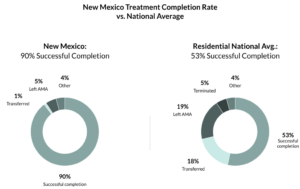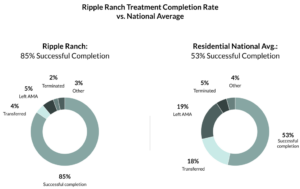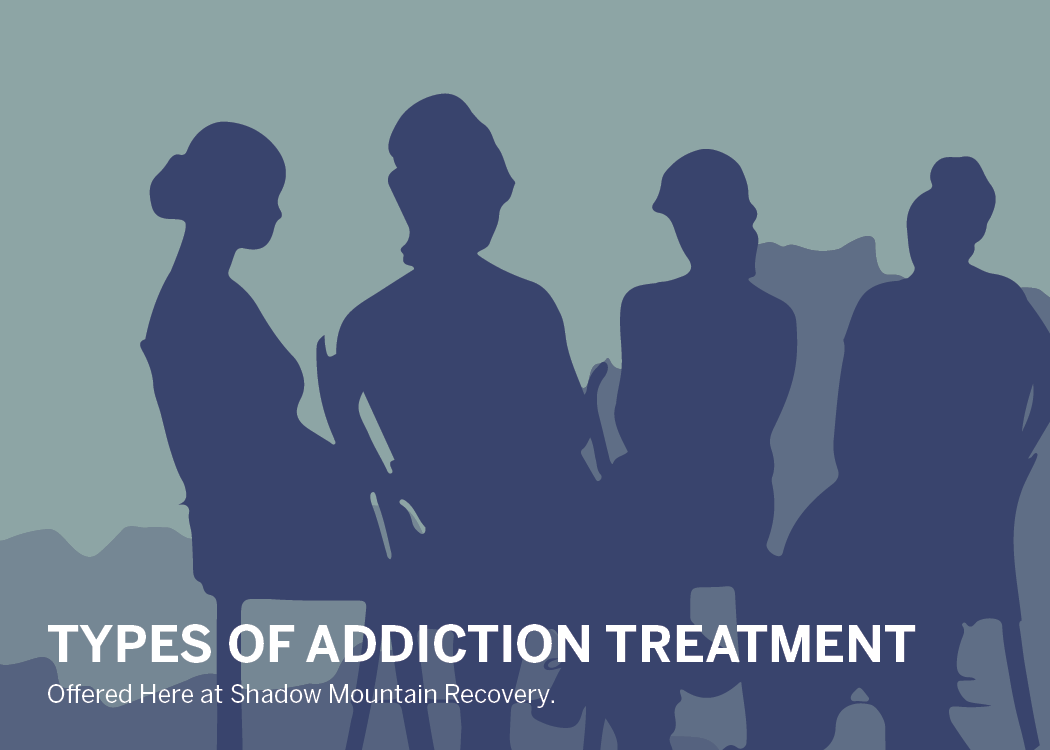Let’s Understand Addiction Treatments Together
There’s a saying about how a journey starts with a single step. It tells you the journey is 1,000 miles, and as memorable sayings go, okay, it’s not bad.
What if you feel like you can’t step, though? What if your journey is longer (or shorter) than that? It’s easy to pick apart metaphors because they’re supposed to mean something to as many people as possible, so they’re usually vague.
Recovery is like a metaphor in that way: it means something different to everyone and it can feel vague and hard to understand. To help as many people as possible achieve lifelong healing from addiction, let’s make sure all the steps on the way to long-term recovery are as clear and defined as possible.
First, let’s make sure you know who Shadow Mountain is, and where we are.
Shadow Mountain Treats Many Types of Addiction
 At the bottom of this site, you’ll see it says: “Shadow Mountain Recovery is a modern, innovative healthcare organization offering a path to recovery to those suffering from substance use and mental health disorders.” What’s that mean though?
At the bottom of this site, you’ll see it says: “Shadow Mountain Recovery is a modern, innovative healthcare organization offering a path to recovery to those suffering from substance use and mental health disorders.” What’s that mean though?
Well, it means we offer lots of treatments, and specifically, we offer alternatives to 12-step programs (but if you’d like a 12-step program, we can do that too), and we specifically focus on evidence-based treatments.
That means the methods we’re using to help you have been studied, and have evidence to support how well they work. Also, we make sure we’re watching exactly how good our own programs are doing by collecting data. Here are some stats that show our completion rates and how they’re well above national averages.


We have three facilities in New Mexico, in Taos, Albuquerque, and Santa Fe.
Now you know who and where we are, let’s talk about the different types of addiction treatment you’ll find at Shadow Mountain.
Types of Addiction Treatment: An Explainer (AKA What Does That Mean?)
An almost endless number of recovery journeys means there are treatments to match up with them. Let’s look at what addiction treatments we have, and explain them all.
Inpatient/Residential Treatment Centers
You might hear Inpatient Treatment or Residential Treatment—they’re the same thing at Shadow Mountain. Inpatient treatment is also sometimes called an “intensive” treatment, but what’s that mean? If someone is really struggling, inpatient treatment is sometimes the first step. It involves staying at Shadow Mountain around the clock, 24/7, and is when detox usually takes place. That doesn’t mean just sitting or lying down in a room and waiting things out, though.
Residential Starts With Detox
Anyone going through detox has licensed MDs and RNs right there with you, every day, all week. Plus, Shadow Mountain uses Medication-Assisted Treatment (MAT), which means we help manage the symptoms of withdrawal with medications, and have comfortable and private rooms where someone can get through detox.
The detox process can last anywhere from a few hours to a few days, or in some cases, a few weeks. It all depends on the situation, and definitely depends on which substance a person is detoxing from.
We want to make sure any concerns are addressed, so individual therapy sessions with licensed professionals not only look at how your addiction formed, but also the coming days, months, and years of recovery.
Partial Hospitalization Programs
This is a version of hospitalization that involves staying off-site, but visiting the treatment facility each day, usually five days a week. If someone needs treatment but doesn’t need help all day, Partial Hospitalization Programs (PHP) offers an intensive structure, and depending on which treatment center it’s taking place at, the schedule may change a little. Normally it’s five days a week, around six hours each day.
Another treatment method that has partial hospitalization is called Intensive Outpatient Programs (IOP), which means the client is visiting the treatment facility two or three days a week. Everyone’s different though, so the decision for how long a day’s treatment lasts will be made after a clinical assessment. Normal length of a day’s treatment can be between three to four hours a day.
Traditional Outpatient Treatment Services For Our Patients
Outpatient services have a longer timeline of scheduled visits, sometimes only once a week, or maybe even once a month, all depending on the individual’s need for treatment. Sometimes the word “therapy” can be used to encompass a huge amount of specific treatment styles, but we want to make sure you understand what they actually mean.
Cognitive Behavioral Therapy (CBT)
 You’ve maybe heard of, or even had CBT and didn’t even know it! Mayo Clinic calls it a “common type of talk therapy,” and that’s one of the reasons people sometimes just call it “therapy.”
You’ve maybe heard of, or even had CBT and didn’t even know it! Mayo Clinic calls it a “common type of talk therapy,” and that’s one of the reasons people sometimes just call it “therapy.”
For CBT you visit a psychotherapist and talk about your problems, but it’s more involved than just talking. A patient named Iris talked to clinical psychologist Judith Johnson about CBT. She said, “For the first time, just letting my emotions out, [the doctor] helped me cry,” and continued by saying, “and by me speaking…it helped me see myself from the inside.”
Doctors usually begin by having you talk about your worries and/or fears, and move forward toward recognizing how your thoughts and behaviors are related to them. They’re there to help you the whole way, it’s never them trying to “get” you, or tell you why you’re wrong. The goal is to come to an understanding of why you think or act negatively, then change that outcome so you’re in control of how you respond to hard situations.
Dialectical Behavioral Therapy (DBT)
A sort of cousin to CBT, most of the time DBT is used to act like the roof built on top of the foundation of CBT. Sometimes DBT is also referred to as a specific kind of CBT, so that can be kind of confusing. The big thing to remember is that DBT is focused on how someone interacts with other people, in certain kinds of social situations.
Therapist Kati Morton describes DBT as having two parts: first, meeting with a licensed therapist, and second, working with a group in therapy sessions. There are honestly a lot of different parts to DBT, with each one having in-depth reasons behind why they’re used. The simplest way to understand it is as a mode of therapy that will give you tools for dealing with situations that show up in your daily life when struggling with addiction, specifically thought patterns and actions you can take to change how you react when you may feel something like the urge to use a harmful substance.
Trauma-Informed Therapy (EMDR)
There are a lot of acronyms in all the different types of treatment. Trauma treatment here at Shadow Mountain is sometimes shortened to EMDR, which stands for eye movement desensitization and reprocessing. Like DBT, there are a lot of parts to the treatment, but let’s look at some stuff we can understand quickly.
Originally designed and used specifically for treating Post-Traumatic Stress Disorder (PTSD), EMDR is now widely used to treat other disorders, including alcohol and substance use. In a study by Sukanya B. Menon and C. Jayan, the eight phases of EMDR are listed as history taking, client preparation, assessment, desensitization, installation, body scan, closure, and reevaluation of treatment effect. First, nothing is actually installed in the body, that phase is where a therapist is aiming at increasing positive reactions and thoughts/emotions, and specifically of replacing the negative versions of those things. It’s basically using your own brain, experiences, thoughts, and actions to “install” positive behaviors and perceptions into your daily life.
Each one of these phases to EMDR is unique and has its own steps (and more acronyms), but it’s the fourth phase, desensitization, that uses eye movement. As explained in this video (which is from overseas, but represents the treatment here at Shadow Mountain accurately), a therapist has you focus on an intense and upsetting image while moving their fingers back and forth in front of you.
The rapid eye movement helps your brain move past the negative imagery and emotions and begin to more easily deal with the negative effects they have on you. It sounds kind of crazy, but the facts don’t lie: a lot of studies have shown that the eye movement portion can result in quick and lasting decreases in negative feelings, along with the severity of stressful thoughts and mental imagery.
Holistic Treatment
The word “holistic” means: “relating to or concerned with wholes or complete systems…”, and that’s exactly how it works at Shadow Mountain: we look at everything that you may be struggling with and address each piece.
Occasionally, when someone is talking about holistic treatment they may be referring to dual diagnosis, which is used to treat co-occurring disorders. What holistic treatment and dual diagnosis mean are that all treatments that may benefit someone are taken into account.
An alcohol or drug use problem may happen at the same time someone is struggling with anxiety, depression, or bipolar disorder. Holistic treatment means a combination of detox, CBT, and continuing medication (if needed) would be used to treat each piece of a specific case.
There Is a Treatment to Help You
All of these different treatments can definitely be like a lot to take in, so don’t be afraid to reach out to us here at Shadow Mountain, even if you’re just calling or emailing with a question.
Although we focus mostly on alternatives to 12-step programs we can provide 12-step treatments if that is what will help. The goal is to provide what we have in order to help you heal for a lifetime. Reach out and let’s talk, call us at 505-657-2117.
Addiction Treatment FAQs
What Are the Four Types of Drugs?
The four types of drugs usually listed as the main types are stimulants (“uppers”), depressants (“downers”), opiate-related painkillers, and hallucinogens. It’s important to remember that there are prescriptions for certain types of the first three. A drug does not have to be bought or sold illegally to be addictive or dangerous.
What Qualifies As an Addiction?
An addiction is when you are using a substance–this could be alcohol, illegal drugs, or even prescription drugs you were given by your doctor–and cannot stop despite negative outcomes. If you can’t get through a day or through day-to-day life without taking the drug or substance, this can qualify as an addiction.
What Are the Effects of the Drugs?
A stimulant creates an “energetic” effect in the body and brain and can also make it difficult to fall asleep or calm down. A depressant has the opposite effect, it creates a “slower” feeling and can lead to exaggerated sleep patterns and lack of energy. Opiate-related painkillers decrease the pain sensation and can also lead to sluggish muscle movements and impaired thinking and motor functions. Hallucinogens create visuals, sounds, and even smells that are not actually happening.
How Do Drugs Affect the Brain?
Some drugs release dopamine, which is occasionally called the “pleasure” chemical. It’s what our brains release to make us feel good and when certain kinds of drugs release more and more of it into our system, our brains can then get used to having a higher level of dopamine than normal. This means when you stop taking the drug or substance that is increasing your dopamine your brain, basically, tells your body that something is wrong because it wants that good feeling back.









